INTRODUCTION
The application of nanotechnology in dentistry was first proposed by Freitas (2000). Nanotechnology is the study and engineering of materials and devices at the nanoscale, which is typically defined as the range of 1–100 nm. At this scale, materials and devices exhibit unique physical, chemical, and biological properties that are not present at larger scales. This allows creating materials and devices with novel properties and functionalities that can be used in various applications. Nanotechnology has the potential to revolutionize every aspect of dental care, including prevention, diagnosis, and treatment. Nanotechnology has been explored extensively in almost all dentistry branches in the past few decades (Sreenivasalu et al., 2022). Many studies also suggested its application in tissue engineering, cancer treatment, and diagnostics (Jin et al., 2020; Khoobchandani et al., 2021; Laird et al., 2021; Sil et al., 2021).
However, many studies have been done in nanotechnology, and no bibliometric analysis has been done on nanotechnology research in dentistry. Bibliometric analysis refers to the quantitative analysis of scientific and scholarly publications. It involves examining publication and citation patterns to understand the impact, visibility, and influence of research in a particular field or discipline. Bibliometric analysis can be used to identify trends in research, measure the impact of specific publications, evaluate the productivity of researchers and institutions, and identify potential collaborators or competitors. It can also be used to assess the quality and importance of research, as well as to inform decisions about funding, policy, and strategy. Bibliometric analysis is critical in the context of academic research, where the assessment of impact and productivity is often based on publication and citation metrics. It can help researchers and institutions to understand how the wider academic community is receiving their work and to identify areas for future research or collaboration. The bibliometric analysis provides a valuable tool for assessing the quality and impact of scientific and scholarly research and making informed decisions about funding, policy, and strategy in academia and beyond.
This study uses a bibliometric approach to review the research pattern on nanotechnology in dentistry. The objective is to identify significant themes, most productive authors, leading institutions and journals, leading countries, co-occurrence of authors, organizations, and keywords from 1999 to 2022 in the field of nanotechnology.
MATERIAL AND METHODS
An online electronic search was performed on 22 August 2022 in the Pubmed database, and articles published on “Nanotechnology application in dentistry” were identified. The search strategy used was—(dentistry AND nanotechnology) OR (dentistry AND nanomaterial) OR (dentistry AND nano-drug) OR (dentistry AND nanoparticles). Article types included review articles, clinical trials, and meta-analyses. Books, documents, and editorials were excluded. No filter was applied for species, language, gender, journal, age, or publication date. The flow chart of the study selection process was generated according to the PRISMA guidelines (Page et al., 2021).
The information about citations, publications, authorship patterns, and keywords from the articles identified in PubMed was exported into MS Excel. The process was repeated by two authors independently, and then the results obtained were cross-checked to avoid any kind of subjective bias. Finally, network analysis and visualization were done with the help of the VOS viewer software (version 1.6.18) and Biblioshiny. Biblioshiny is a shiny app providing a web interface for bibliometrix- an R-tool for comprehensive science mapping analysis (Aria and Cuccurullo, 2017).
The following aspects were analyzed:
(i) Publishing trends,
(ii) the authors with the highest number of publications and their co-occurrence,
(iii) the most commonly used keywords and their co-occurrence,
(iv) the organizations with the highest number of publications related to nanotechnology in dentistry, and their co-occurrences
(v) the countries with the highest number of publications related to nanotechnology in dentistry and their collaboration frequency
(vi) most relevant journals in the field of nanotechnology in dentistry, and
(vii) Average link strength between various authors, organizations, and keywords. The greater the link strength, the stronger the co-occurrence.
RESULTS
The initial search yielded 5,898 documents published between the years 1999 and 2022. After selecting the article type, 913 articles were left, of which 673 were reviews, 213 were clinical trials, 14 were systematic reviews, and 13 were meta-analyses (Fig. 1). The graph plotted between the number of publications and the year of publication shows the research pattern in the field of nanotechnology in dentistry (Fig. 2).
Publishing trend of articles
The first publication on the topic was published in the year 2000. Then, there was a slight increase in 2010, followed by a small reduction. Finally, a significant increase can be noticed in 2018, with 97 publications published. The maximum number of research papers (N = 149) was published in 2021.
Most relevant authors
This bibliometric analysis identified Tayebi L, Kim HW, Sharifi S, Maleki Dizaj S, and Mozafari M has been recognized as the most contributing authors in the field of nanotechnology in dentistry, with the number of publications ranging from 12 to 17 (Fig. 3).
A total of 4,127 authors were identified, of which 47 authors have more than five articles in the field of nanotechnology in dentistry. The average link of strength was 9.62, ranging from 0 to 70. Network analysis included 513 authors who had at least two publications. Figure 4 represents the largest connected network of 154 authors with 11 clusters and 693 links. The shorter the distance between circles representing authors, the stronger the link between them. The circle size represents the number of publications.
Analysis of organization
Articles had been written by authors belonging to 2,968 organizations/institutions or research centers. Only 11 organizations have more than five publications. The network analysis included 157 organizations with more than two publications. The most extensive set of related items comprised 68, including 8 clusters and 254 links (Fig. 5). The total link strength was found to be 342. The number of items in the collection ranges from 5 to 14. Out of 10 organizations with the highest co-occurrence, 5 are non-dental organizations (Table 1).
Analysis suggests that Tabriz University of medical sciences in Iran is the major contributor with the leading publication (16.3%), followed by Dankook University, University of Queensland, and Tehran University of Medical Sciences. The top five universities contribute 47.86% of total publications (Fig. 6).
Keywords analysis
The analysis yielded a list of 3,276 keywords, 343 (10.47%) of which co-occurred more than five times. 5 clusters were generated for 343 items (ranging from 20 to 174) with a total of 11,149 links and total link strength of 39,760. Keywords with the highest co-occurrences included non-specific terms, such as humans, animals, male, female, etc. The terms specific to the field and with the highest co-occurrence are nanoparticles, nanotechnology, surface properties, and nanostructures (Fig. 7).
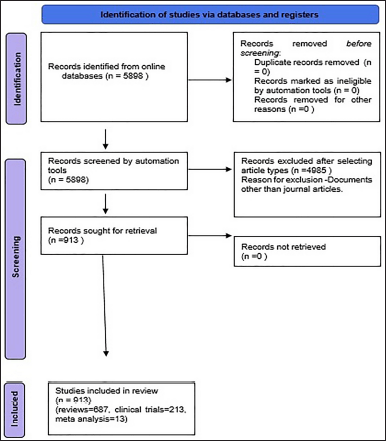 | Figure 1. Flow chart – process of selection of studies. [Click here to view] |
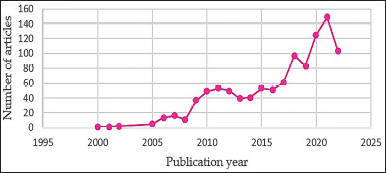 | Figure 2. The research trend in the field of nanotechnology in dentistry. [Click here to view] |
Trend topic analysis and thematic evaluation
The trend topic analysis suggests an increase in the use of the term drug delivery system while a decrease in the use of the terms nanoparticles and polymers. The research trend shifted from dental materials to tissue engineering and drug delivery from 2006 to 2021. The analysis highlights that the most commonly used terms between 2009 and 2017 were chemical properties, surface properties, dental bonding agent, etc. In 2015, the term “dental caries prevention and control” was used frequently. From 2018 to 2022, the most common terms used were therapeutic uses, drug delivery system, implant, tissue engineering, and drug carriers. Thus, research trends have shifted from the properties of nanomaterials to practical applications (Fig. 8).
The thematic evaluation graph shows how the themes have changed with progress in the past 22 years (Fig. 9).
Three field plot
The three-field plot analysis indicates that all leading countries contribute to human and animal studies, but human studies are more than animal studies. Most animal studies occur in Iran, China, and the USA. In Brazil, Italy, Saudi Arabia, Australia, India, and Canada, most studies are done on humans and very few on animals (Fig. 10).
In Brazil and Italy, the study population is mainly middle-aged. Brazil primarily contributes to the research on material testing, composite resin, and dental materials/chemistry. Research papers from China, Brazil, the USA, and Iran mainly use surface property.
Most of the articles from Iran are published in the International Journal of Nanomedicine. All the research papers from Australia are published in Nanomaterials, Materials, and the Journal of Dental Research. Most publications from the USA are in the Journal of Dental Research. Most of the research papers from Brazil are published in Clinical Oral Investigation and the Journal of Dentistry. In contrast, research papers from Italy are primarily published in nanomaterial and the International Journal of Molecular Sciences. The two journals – nanomaterials and International Journal of Nanomedicine, published research papers from India, Saudi Arabia, and Korea.
Most relevant sources
Nanomaterials have the highest number of publications (3.39%), followed by dental material: official publication of the Academy of Dental Materials (2.6%), Operative Dentistry (2.6%), International Journal of Molecular Sciences (2.4%), and Oral Clinical Investigations (2.3%). The 10 most relevant journals (Table 2) belong to the Q1 (6 journals) and Q2 (4 journals) categories and contribute 23.22% of the total publications selected for the analysis. Their H index ranges from 77 to 195 (According to Scopus).
Analysis of countries and their collaboration frequency
Iran is the most contributing country, followed by USA, Brazil, China, and India. Iran has an approximately equal percentage (50%) of single-country publications (SCP) and multiple-country publications (MCP), whereas Sweden is the country with only SCP (Fig. 11). In Saudi Arabia, there are more MCP than SCP. In most of the corresponding author’s countries, SCP is more than MCP.
The country with the highest collaboration frequency is the USA; it collaborates with China, Italy, Brazil, and India. The highest frequency of collaboration is between Iran and USA. Iran also collaborates with Italy with a collaboration frequency of 18. India collaborates with Saudi Arabia and Malaysia. Another partnership with high frequency can be seen between China, Australia, and Italy (Table 3).
DISCUSSION
The publishing trend of nanotechnology applications in dentistry has grown gradually since 2010, and exponential growth occurred after 2017. The maximum number of research papers were published in the year 2021. A slight drop in publications can be observed in 2019, which may be attributed to the COVID-19 pandemic (Fig. 2).
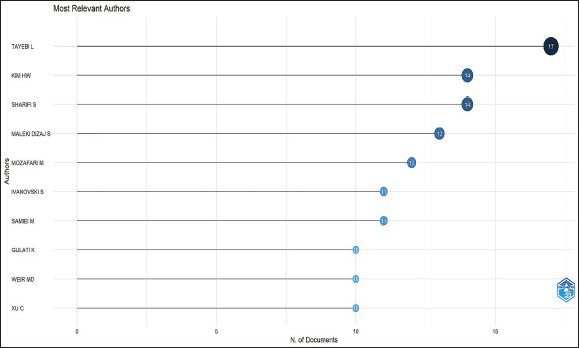 | Figure 3. Most contributing authors in the field of nanotechnology in dentistry. [Click here to view] |
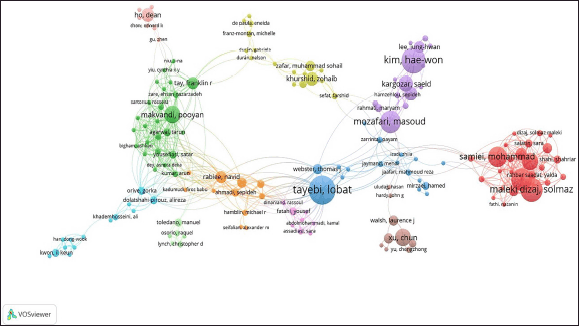 | Figure 4. The total strength of co-authorship links in the field of nanodentistry. All authors from the same cluster are shown with the same color. The circle size represents the number of publications. The link color is consistent with the color of their source clusters. [Click here to view] |
The trend-topic analysis indicates that initially, research was focused on chemical properties, surface properties, and effects on dental materials. In contrast, research is now focused more on practical applications such as tissue engineering, drug delivery system, biocompatible implant materials, and drug carriers.
Nanotechnology is a rapidly growing field that significantly contributes to many areas of medicine, including dentistry. Nanotechnology is being used to develop new dental materials that are stronger, more durable, and more resistant to wear and tear. Nanoparticles can be designed to deliver drugs directly to the site of oral infection (Lal et al., 2021). This approach minimizes the exposure of healthy tissue to drugs and reduces the risk of side effects. Nanotechnology is being used to improve the design and function of dental implants. Nanoscale coatings can be applied to implant surfaces to enhance the integration of the implant with the surrounding bone tissue, reducing the risk of implant failure (Parnia et al., 2017).
It is a rapidly growing field that deals with the design, production, and application of materials and devices on a nanoscale level. In recent years, there has been an increasing interest in applying nanotechnology to dentistry as it has the potential to revolutionize the field, offering new and innovative solutions for a range of dental problems. As a result, there has been a significant increase in research in this area in recent years.
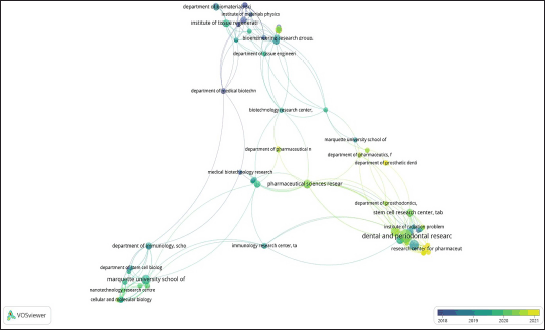 | Figure 5. Overlay visualization of organizations related to the research in nanodentistry. The circle size represents the number of publications. The link color is consistent with the color of their related organization. [Click here to view] |
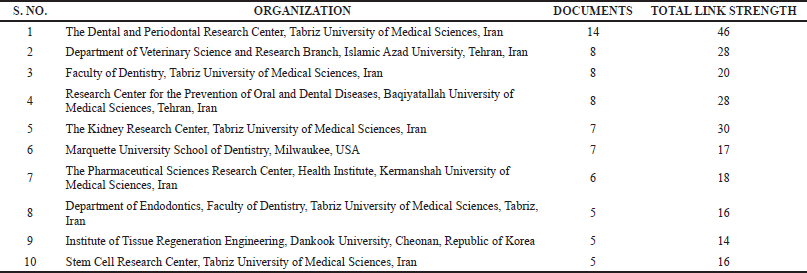 | Table 1. Co-occurrence of organizations related to the field of nanodentistry. [Click here to view] |
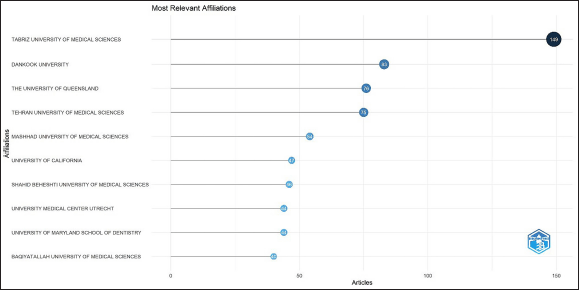 | Figure 6. Most contributing universities in the field of nanodentistry. [Click here to view] |
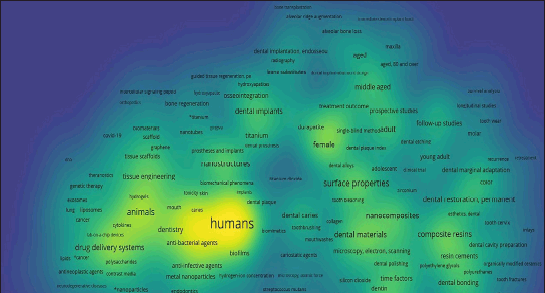 | Figure 7. Density visualization of co-occurrence of keywords in nanodentistry. The bigger font size and yellow color represent more frequently used keywords. The distance between keywords increases as their frequency of co-occurrence decreases. [Click here to view] |
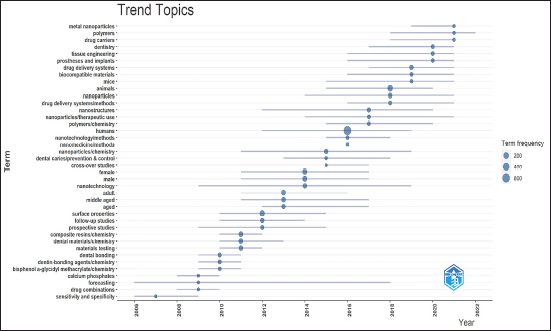 | Figure 8. Trend topic analysis in the field of nanodentistry. [Click here to view] |
To our knowledge, no bibliometric analysis has been published on this topic. However, very few bibliometric studies have been identified related to the field. A bibliometric analysis of published studies on electrospun nanofibers for dentistry from 2004 to 2021 (Jin et al., 2018) highlighted that China has the maximum number of publications and the highest h-index, followed by the USA, Iran, England, and South Korea related to electrospun nanofibers in dentistry. The significant contributors identified are China, the USA, and India in reactive oxygen species-based nanotechnology applied to cardiovascular diseases (Liang et al., 2022). On the contrary, our analysis identified Iran as the most productive country in this field and Tabriz University of medical sciences (Iran) as a top contributor with 149 publications. Another study determined that leading countries in the research of Silver diamine fluoride (SDF) use in dentistry are the United States of America, Hong Kong, and Japan (Qasim et al., 2021).
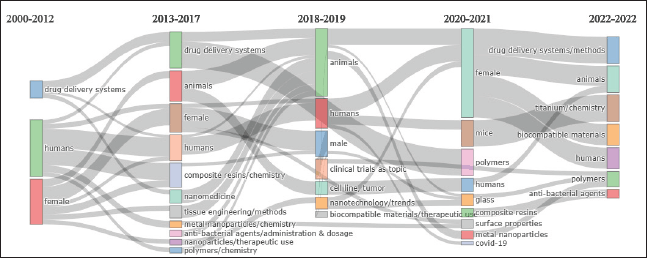 | Figure 9. Thematic evolution analysis (by Biblioshiny). It identifies changes in terminology and evolution in study themes related to nanodentistry. [Click here to view] |
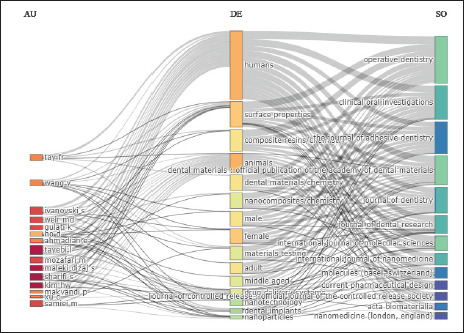 | Figure 10. Three field plots, AU = Author’s country, DE = keywords, SO = Source (parameters selected—AU = 15, DE = 15, and sources = 15). It represents the interrelations between various countries, sources of scientific articles and keywords. [Click here to view] |
The maximum bibliographic coupling was found among authors from various academic institutions in Hong Kong in SDF research (Qasim et al., 2021). In our study, the highest collaboration frequency is identified between Iran and the United States of America.
SDF and dental caries have been the most frequently used term during the last decade (Qasim et al., 2021). The latest terms indicated in the electrospun nanofibers research are bone regeneration, tissue regeneration, cell differentiation and proliferation, and drug delivery. Most studies have focused on periodontal regeneration (Jin et al., 2018). According to our analysis, the most frequently used keywords are human, nanoparticles, animal, surface properties, nanotechnology, and nanostructures.
The keywords indicate the areas of research in various subbranches of nanotechnology. According to the study done on nanomedicine, in the past 3–4 years, drug delivery system has become a primary focus area of research in nanomedicine. Another study identified nanoparticles and drug delivery as hot research topics and identified the USA, China, and India as countries with the highest co-occurrence frequency (Zhang et al., 2022). A similar finding is observed in our study too. According to our network analysis, the nanoparticle is the keyword specific to the field with the highest co-occurrence.
A bibliometric analysis of nanomedicine first identified the USA as a significant contributor country and the International Journal of Nanomedicine as a major contributor journal in the field (Bragazzi, 2019). In addition, the International Journal of Nanomedicine has been identified as a significant contribution to nanomedicine applications in head and neck squamous cell carcinoma (Gao et al., 2021). Our analysis identified nanomaterials as the most relevant source with 31 publications.
 | Table 2. Number of publications in leading journals in nanodentistry. [Click here to view] |
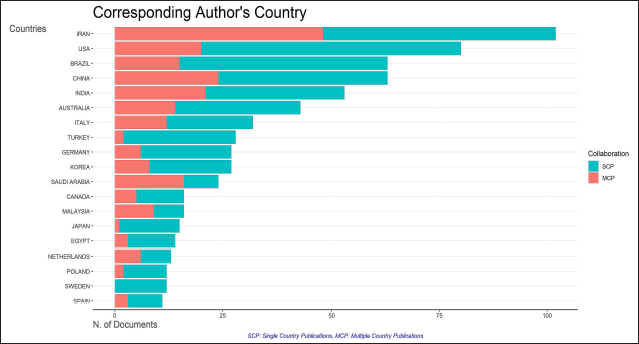 | Figure 11. Number of documents published in collaboration with leading countries in nanodentistry. [Click here to view] |
 | Table 3. Frequency of collaboration between various countries in research in the field of nanodentistry. [Click here to view] |
The differences in results of various published studies can be because these studies are limited to only one aspect of nanotechnology in dentistry. In contrast, our study provides a broader picture of the field.
The study’s main limitation is that the conclusion is based on the data obtained from only one database. Another limitation is that the investigation is quantitative, and the quality of individual papers was not analyzed. Regardless of these limitations, this study could aid in identifying research patterns and trends. Also, it would help identify the leading researchers and organizations for budding researchers.
CONCLUSION
The analysis provides valuable information on the total number of publications on nanotechnology in dentistry from 1999 to 2022. It has shown a gradual increase in publishing trends on the topic with an upsurge after 2010. Trend analysis shows that the research in nanodentistry has focused more on drug delivery systems and tissue engineering in the past few years. Iran and USA have been identified as the most productive country, and “Nanomaterials” is the journal with the highest number of publications in nanodentistry. The analysis has also identified the leading researchers, organizations, and related research trends.
Overall, nanotechnology has the potential to significantly improve the diagnosis and treatment of dental diseases, as well as the design and function of dental materials and implants. However, more research is needed to fully realize the potential of nanotechnology in dentistry and to address any potential safety concerns associated with these new technologies.
KEY FINDINGS
The publishing trend of nanotechnology applications in dentistry has grown gradually since 2010, and exponential growth occurred after 2017. The maximum number of research papers were published in the year 2021. A slight drop in publications can be observed in 2019, which may be attributed to the COVID-19 pandemic (Fig. 2). The analysis identified Iran as the most productive country in this field. The most frequently used keywords are human, nanoparticles, animal, surface properties, nanotechnology, nanostructures, etc. The most relevant source is nanomaterials, with 31 publications. According to the analysis, the nanoparticle is the keyword specific to the field with the highest co-occurrence. Tayebi L, Kim HW, and Sharifi S are identified as prominent contributing authors here. Tabriz University of medical sciences (Iran) is recognized as a top contributor with 149 publications. Collaboration frequency is highest between Iran and the United States of America. Research trends have shifted from the chemical properties of nanomaterials to practical applications such as tissue engineering and drug delivery system.
AUTHOR CONTRIBUTIONS
All authors made substantial contributions to the conception and design, acquisition of data, or analysis and interpretation of data; took part in drafting the article or revising it critically for important intellectual content; agreed to submit to the current journal; gave final approval of the version to be published; and agreed to be accountable for all aspects of the work. All the authors are eligible to be an author as per the international committee of medical journal editors (ICMJE) requirements/guidelines.
FINANCIAL SUPPORT
This research received no external funding.
CONFLICTS OF INTEREST
The authors declare no conflict of interest.
ETHICAL APPROVALS
This study does not involve experiments on animals or human subjects.
DATA AVAILABILITY
All the data is available with the authors and shall be provided upon request.
PUBLISHER’S NOTE
This journal remains neutral with regard to jurisdictional claims in published institutional affiliation.
REFERENCES
Aria M, Cuccurullo C. Bibliometrix: an R-tool for comprehensive science mapping analysis. J Informetr, 2017; 11(4):959–75. CrossRef
Bragazzi NL. Nanomedicine: insights from a bibliometrics-based analysis of emerging publishing and research trends. Medicina, 2019; 55(12):785; Doi:10.3390/medicina55120785 CrossRef
Freitas RA. Nanodentistry. J Am Dent Assoc, 2000; 131(11):1559–65; doi: 10.14219/jada.archive.2000.0084 CrossRef
Gao X, Wang S, Tian Z, Wu Y, Liu W. A bibliometric analysis on studies of nanomedicine applications in head and neck squamous cell carcinoma. Transl Cancer Res, 2021; 10(1):251–60; doi: 10.21037/tcr-20-2852 CrossRef
Jin C, Wang K, Oppong-Gyebi A, Hu J. Application of nanotechnology in cancer diagnosis and therapy—a mini-review. Int J Med Sci, 2020; 17(18):2964–73; doi: 10.7150/ijms.49801 CrossRef
Jin S, Xin B, Zheng Y, Liu S. Effect of electric field on the directly electrospun nanofiber yarns: simulation and experimental study. Fibers Polym, 2018; 19:116–24; doi:10.1007/s12221-018-7734-2 CrossRef
Khoobchandani M, Khan A, Katti KK, Thipe VC, Al-Yasiri AY, MohanDoss DKD, Nicholl MB, Lugão AB, Hans CP, Katti KV. Green nanotechnology of MGF-AuNPs for immunomodulatory intervention in prostate cancer therapy. Sci Rep, 2021; 11(1):16797; doi: 10.1038/s41598-021-96224-8 CrossRef
Laird NZ, Acri TM, Chakka JL, Quarterman JC, Malkawi WI, Elangovan S, Salem AK. Applications of nanotechnology in 3D printed tissue engineering scaffolds. Eur J Pharm Biopharm, 2021; 161:15–28; doi: 10.1016/j.ejpb.2021.01.018 CrossRef
Lal A, Alam MK, Ahmed N, Maqsood A, Al-Qaisi RK, Shrivastava D, Alkhalaf ZA, Alanazi AM, Alshubrmi HR, Sghaireen MG, Srivastava KC. Nano drug delivery platforms for dental application: infection control and TMJ management-a review. Polymers (Basel), 2021; 13(23):4175; doi: 10.3390/polym13234175 CrossRef
Liang Y, Liao S, Zhang X. A bibliometric analysis of reactive oxygen species based nanotechnology for cardiovascular diseases. Front Cardiovasc Med, 2022; 9:940769; doi: 10.3389/fcvm.2022.940769 CrossRef
Page MJ, McKenzie JE, Bossuyt PM, Boutron I, Hoffmann TC, Mulrow CD, Shamseer L, Tetzlaff JM, Akl EA, Brennan SE, Chou R, Glanville J, Grimshaw JM, Hróbjartsson A, Lalu MM, Li T, Loder EW, Mayo-Wilson E, McDonald S, McGuinness LA, Stewart LA, Thomas J, Tricco AC, Welch VA, Whiting P, Moher D. The PRISMA 2020 statement: an updated guideline for reporting systematic reviews. BMJ, 2021; 372:n71; doi: 10.1136/bmj.n71 CrossRef
Parnia F, Yazdani J, Javaherzadeh V, Maleki Dizaj S. Overview of nanoparticle coating of dental implants for enhanced osseointegration and antimicrobial purposes. J Pharm Pharm Sci, 2017; 20(0):148–60; doi: 10.18433/J3GP6G CrossRef
Qasim SSB, Ali D, Khan AS, Rehman SU, Iqbal A, Baskaradoss JK. Evidence-based bibliometric analysis of research on silver diamine fluoride use in dentistry. Biomed Res Int, 2021; 2021:9917408; doi: 10.1155/2021/9917408 CrossRef
Sil BK, Jamiruddin MR, Haq MA, Khondoker MU, Jahan N, Khandker SS, Ali T, Oishee MJ, Kaitsuka T, Mie M, Tomizawa K, Kobatake E, Haque M, Adnan N. AuNP coupled rapid flow-through dot-blot immuno-assay for enhanced detection of SARS-CoV-2 specific nucleocapsid and receptor binding domain IgG. Int J Nanomed, 2021; 16:4739–53; doi: 10.2147/IJN.S313140 CrossRef
Sreenivasalu PKP, Dora CP, Swami R, Jasthi VC, Shiroorkar PN, Nagaraja S, Asdaq SMB, Anwer MK. Nanomaterials in dentistry: current applications and future scope. Nanomaterials (Basel), 2022; 12(10):1676; doi: 10.3390/nano12101676 CrossRef
Zhang X, Guo M, Huang Z, Huang Y, Wu C, Xin X. Mapping the intersection of nanotechnology and SARS-CoV-2/COVID-19: a bibliometric analysis. Infect Med, 2022; 1(2):103–12; doi:10.1016/j.imj.2022.06.005 CrossRef